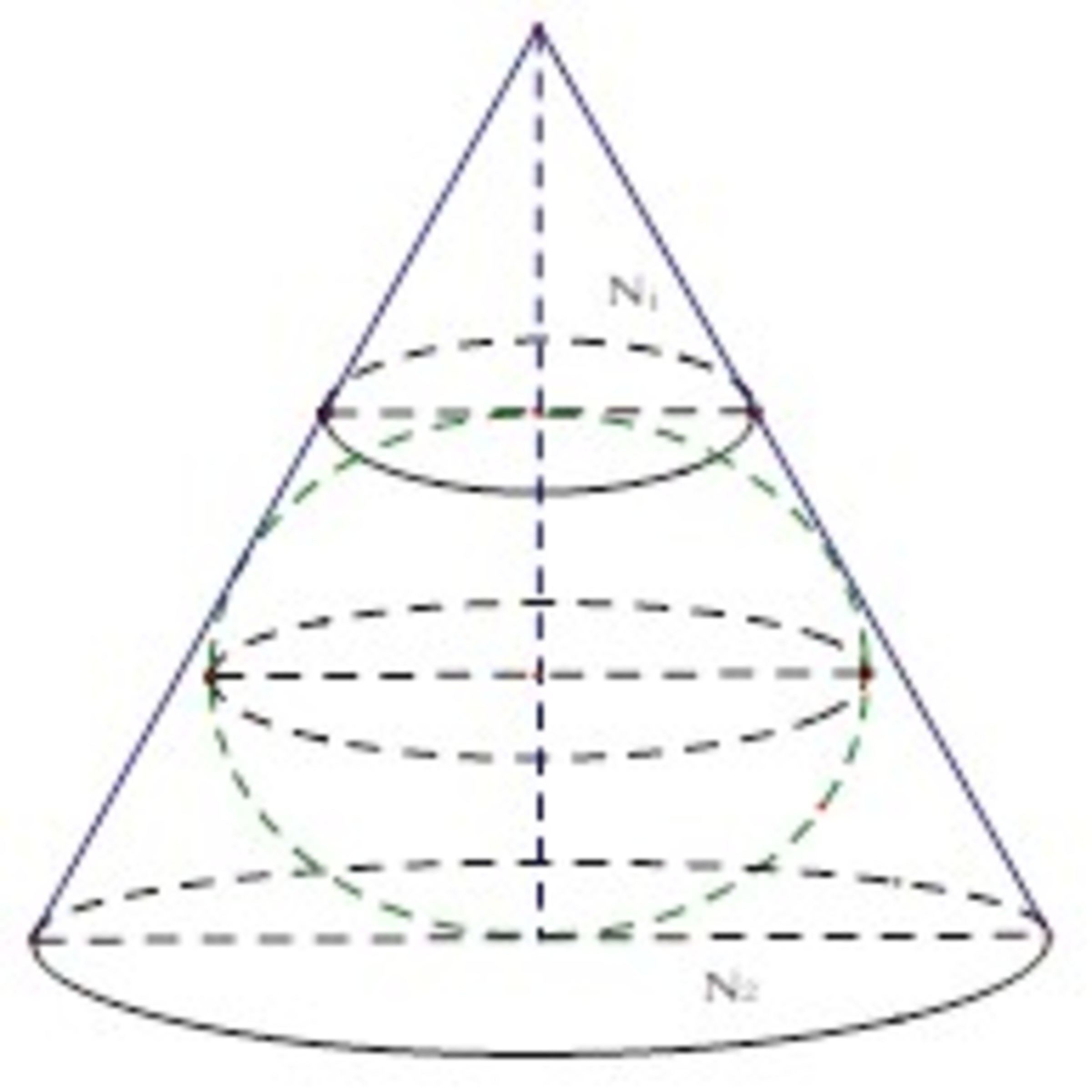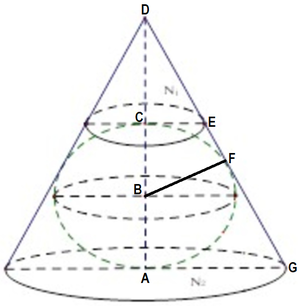Geometry problem No.3
Given a cone ( N ) is divided by a plane ( P ) which is in parallel with the base into two parts namely ( N 1 ) and ( N 2 ) . An inscribed sphere ( S ) of ( N 2 ) so that V ( S ) = 2 1 V ( N 2 ) . The cross section of ( N 2 ) and a plane contains its axis is a isosceles trapezoid. Find the tangent of the acute angles of the trapezoid.

The answer is 2.
This section requires Javascript.
You are seeing this because something didn't load right. We suggest you, (a) try
refreshing the page, (b) enabling javascript if it is disabled on your browser and,
finally, (c)
loading the
non-javascript version of this page
. We're sorry about the hassle.
3 solutions
Label the diagram as follows, where E is the point of tangency between the sphere and the cone:

Let C D = 1 , x = A C , r = C E , and R = A G , so that A B = B C = B F = 2 1 x .
Since △ B F D ∼ △ G A D by AA similarity, B D B F = D G A G , or 2 1 x + 1 2 1 x = R 2 + ( x + 1 ) 2 R , which rearranges to R = 2 1 x x + 1 .
Since V S = 2 1 V N 2 , 3 4 π B F 3 = 2 1 ( 3 1 π ⋅ A G 2 ⋅ A D − 3 1 π ⋅ C E 2 ⋅ C D ) , or 3 4 π ( 2 1 x ) 3 = 2 1 ( 3 1 π ⋅ R 2 ⋅ ( x + 1 ) − 3 1 π ⋅ r 2 ⋅ 1 ) , or x 3 = R 2 ( x + 1 ) − r 2 .
Substituting R = 2 1 x x + 1 into x 3 = R 2 ( x + 1 ) − r 2 gives x 3 = ( 2 1 x x + 1 ) 2 ( x + 1 ) − r 2 , which rearranges to r = 2 1 x ( x − 1 ) .
Finally, since △ B F D ∼ △ E C D by AA similarity, x + 1 R = 1 r , or x + 1 2 1 x x + 1 = 1 2 1 x ( x − 1 ) , which solves to x = 2 1 + 5 = ϕ (the golden ratio!)
Therefore, the tangent of the acute angle in the isosceles trapezoid is t = A G A D = C E C D = r 1 = 2 1 x ( x − 1 ) 1 = 2 1 ϕ ( ϕ − 1 ) 1 = 2 1 ⋅ 1 1 = 2 .
V(S) = V(N2) / 2
= 4πr³ / 3
V(N2) = 8πr³ / 3
= π[ (a² + 4[(a + b) / 2]² + b²) / 6 ] × [ 2r ]
= π(2a² + 2ab + 2b²)(2r) / 6
= π(a² + ab + b²)(2r) / 3
where a is the upper base radius and b is the lower base radius of N2.
(2r)² = a² + ab + b²
(Hypothenuse)² = (base leg)² + (height leg)²
(a + b)² = (b – a)² + (2r)²
a² + 2ab + b² = b² – 2ab + a² + (2r)²
(2r)² = 4ab
r² = ab
(b – a)² = b² – 2ab + a²
= (a² + ab + b²) – 3ab
= (2r)² – 3r²
= r²
Tan theta = (2r) / (b – a)
= 2r / r
= 2
Let h 1 be the distance along the axis from the apex to the center of the upper base of the conical frustum.
The upper base radius is r 1 = h 1 tan θ
The lower base radius is r 2 = tan θ ( h 1 + 2 R )
The difference in volume between the two cones with the two bases specified above is
V 1 = 3 1 π r 2 2 ( h 1 + 2 R ) − 3 1 π r 1 2 h 1
= 3 1 π tan 2 θ ( ( h 1 + 2 R ) 3 − h 1 3 )
= 3 1 π tan 2 θ ( 6 h 1 2 R + 1 2 h 1 R 2 + 8 R 3 )
= 3 2 π R 3 tan 2 θ ( 3 ( h 1 / R ) 2 + 6 ( h 1 / R ) + 4 )
We also have that the lateral (slant) height of the frustum is
s = r 1 + r 2 = ( r 1 − r 2 ) 2 + ( 2 R ) 2
From which it follows that r 1 r 2 = R 2
but this means that tan 2 θ ( h 1 2 + 2 R h 1 ) = R 2
therefore, tan 2 θ ( ( h 1 / R ) 2 + 2 ( h 1 / R ) ) = 1
Use this last equation in the expression for the volume:
V 1 = 3 2 π R 3 ( 3 tan 2 θ ( ( h 1 / R ) 2 + 2 ( h 1 / R ) ) + 4 tan 2 θ ) = 3 2 π R 3 ( 3 + 4 tan 2 θ )
but this volume is twice the volume of the sphere, hence,
3 1 π R 3 ( 3 + 4 tan 2 θ ) = 3 4 π R 3
thus, 3 + 4 tan 2 θ = 4
so that, tan θ = 2 1
therefore, tan φ = ( 2 1 ) − 1 = 2